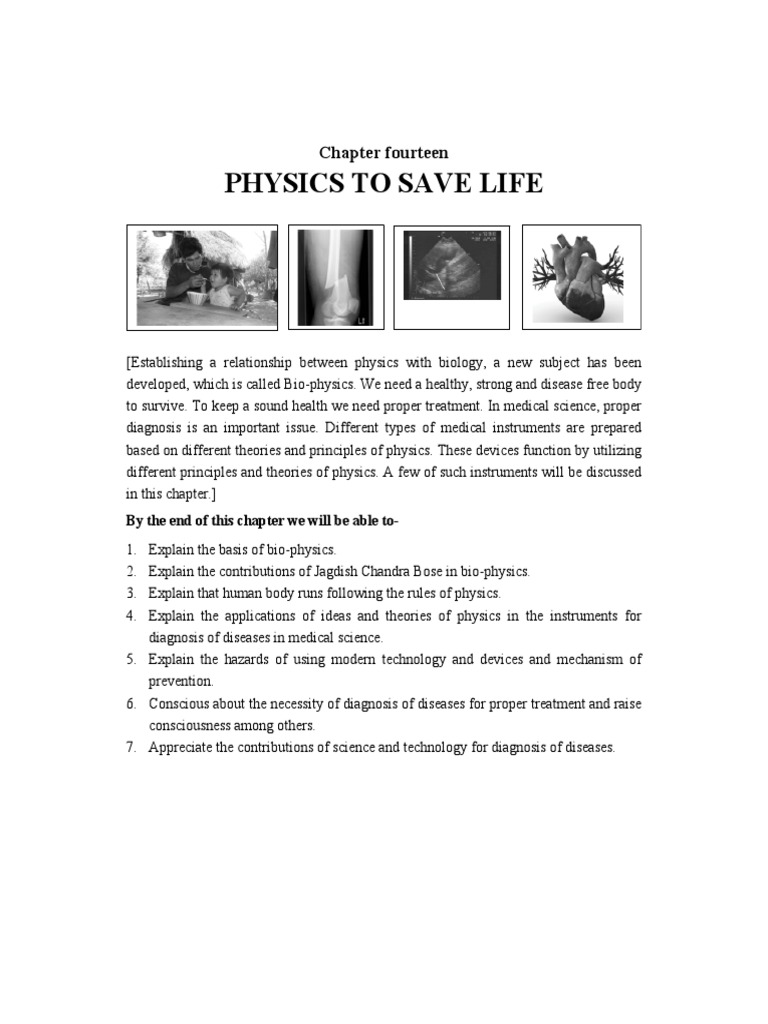Physics, the foundational science of matter and energy, has profound implications and applications in the realm of medicine, offering transformative methodologies for diagnosis, treatment, and research. The intersection of these two fields fosters an understanding of complex physiological phenomena through a quantitative lens. This article explores the myriad ways in which physics is employed in medicine, exposing not just a reliance on technological advancement but also an underlying fascination with the physics of life itself.
One of the most ubiquitous applications of physics in medicine is medical imaging. Techniques such as X-rays, magnetic resonance imaging (MRI), and computed tomography (CT) scans exemplify this relationship. X-ray technology, based on the principle of electromagnetic radiation and its differential absorption by various tissues, has revolutionized diagnostics. The variation in density between bone and soft tissue allows radiologists to visualize internal structures, facilitating the identification of fractures and tumors.
MRI technology, on the other hand, utilizes principles of nuclear magnetic resonance, a concept deeply rooted in quantum mechanics. By manipulating magnetic fields and radio waves, MRI provides detailed images of soft tissues, enabling the analysis of brain disorders, musculoskeletal injuries, and even cardiac function. The depth of insight gained from MRI scans has not only enhanced diagnostic capabilities but has also fostered advancements in surgical technique and pre-operative planning.
CT scans integrate X-ray technology and computer algorithms to produce cross-sectional images of the body, providing intricate details that traditional X-rays cannot. The physical principle of Tomography, which describes the imaging of slices through an object, underscores the complexity of the body’s internal structures. Utilizing this technology, healthcare professionals can make more informed decisions, ultimately improving patient outcomes.
Beyond imaging, another significant application of physics in medicine is found in radiation therapy. The therapeutic use of ionizing radiation to treat cancer exemplifies the clinical application of dose distribution and energy deposition. The physical principles of radiobiology elucidate how cancer cells respond to radiation at the molecular level, enabling oncologists to devise individualized treatment plans. By employing targeted radiation, medical physicists can minimize damage to surrounding healthy tissues while maximizing the therapeutic effects on malignant cells.
The field of biophysics also serves as a pivotal bridge between physics and medicine. By investigating biological systems through the lens of physical principles, researchers can uncover the mechanics of cellular processes, enzymatic functions, and molecular interactions. Techniques such as fluorescence microscopy and atomic force microscopy allow for the observation of cellular structures in unprecedented detail, facilitating advancements in drug development and delivery mechanisms. The ability to manipulate biomolecular interactions using physical principles showcases how fundamental physics concepts play a vital role in understanding health and disease.
Furthermore, the principles of fluid dynamics—central to physics—are crucial in understanding bodily functions such as blood flow, respiration, and the mechanics of cardiovascular health. Hemodynamics, the study of blood flow, relies on the application of fluid dynamics to assess cardiovascular health and develop artificial devices, such as stents and heart pumps. The intricate magnetohydrodynamics governing the behavior of blood flow under varying conditions provides insights into cardiovascular pathologies, including atherosclerosis and hypertension.
One cannot overlook the significance of ultrasound technology, another embodiment of physics in medical practice. Utilizing high-frequency sound waves to create images of internal structures, ultrasound has become invaluable in obstetrics, cardiology, and emergency medicine. The physics of sound propagation and reflection allows for real-time visualization of organ function and fetal development. As technology advances, applications of ultrasound are expanding, paving the way toward non-invasive diagnostic techniques that minimize risk for patients.
The integration of physics into therapeutic techniques can also be observed in fields such as biomechanics. Understanding the mechanics of human movement requires elaborate calculations involving forces, torques, and energy expenditure. This knowledge not only enhances the rehabilitation protocols prescribed for injury recovery but also contributes to the development of orthotic devices and prosthetics. The quest for creating more adaptive and responsive assistive technologies highlights the profound interplay between physics and human biomechanics.
Moreover, advancements in pharmacology are increasingly reliant on the principles of physics. Nanotechnology, a frontier discipline, employs physical concepts to manipulate materials at the molecular level, facilitating targeted drug delivery systems that improve efficacy while reducing side effects. The concept of drug kinetics, influenced by diffusion, convection, and molecular properties, underscores the necessity for a solid understanding of the underlying physical principles that govern these processes.
The exploration of the cosmos, too, has implications in medical physics. Techniques developed for space exploration contribute to advancements in imaging technologies and materials science. For example, radiation shielding developed for spacecraft has been adapted for use in protective medical gear, enhancing safety during radiation-related procedures.
As the fields of physics and medicine converge, the potential for innovative solutions is boundless. The synergy of these disciplines not only enhances numerous medical practices but also deepens our understanding of the complex natural world. The interplay between physical laws and biological phenomena reveals a fascinating narrative; one that continually beckons inquiry and inspires advancements poised to transform healthcare as we know it.
In conclusion, the applications of physics in medicine underscore a profound relationship that extends beyond the mere application of technology. It is a narrative steeped in curiosity and the quest for knowledge, bridging the gap between two seemingly disparate fields. The pursuit of understanding how physics informs medicine reflects humanity’s inherent desire to unravel the mysteries of existence, reinforcing our commitment to caring for health and enhancing the quality of life.












